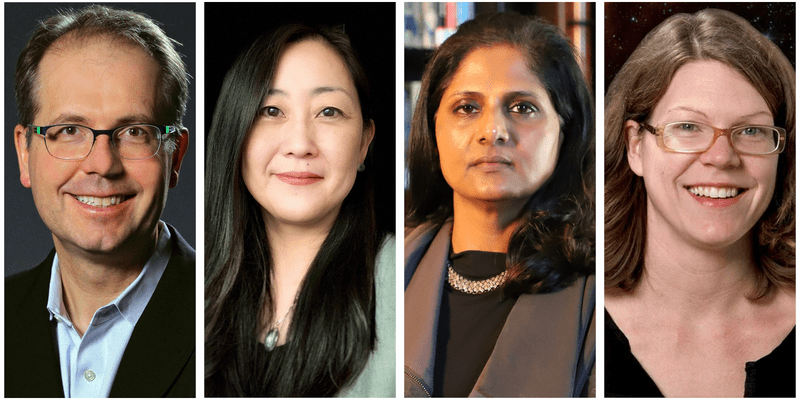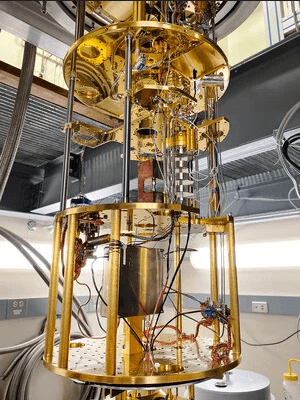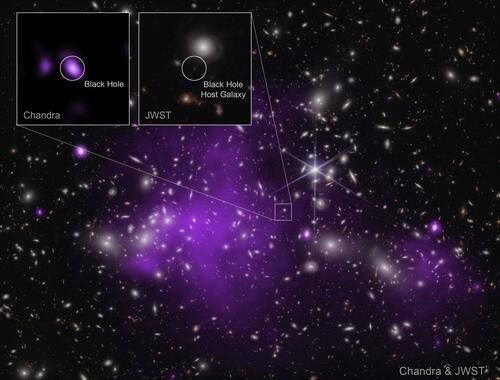The biggest—and smallest—questions
From neutrinos to maps of the entire universe, Faculty of Arts and Sciences physicists and cosmologists are exploring the unseen in a quest to understand the most far-reaching scientific mysteries.

The coldest cubic meter in the known universe lies beneath a mountain in Italy. There, in Gran Sasso National Laboratory, researchers hope to catch a neutrino behaving in extraordinary ways in a refrigerator set to nearly absolute zero. If they do, they will solve a puzzle that has bedeviled physicists for generations—and upend current thinking in physics.
As physicists, cosmologists, and astronomers coax the unseen to reveal itself, one question keeps creating another. The pursuit of mysteries like how black holes work, what dark matter and dark energy are, and how the universe arose gives rise to strange contradictions. Much of the experimental work is done in superlatively cold, dustless, or dry conditions. Unimaginably small particles could explain the most titanic of cosmological phenomena. The most abundant forms of matter and energy are the hardest ones to observe. Being wrong can be almost more rewarding than being right. And disciplines that seem totally unrelated can richly inform the work.
“The universe, as far as we know, is made of regular matter like you and me. But that matter only constitutes something like five percent of the universe,” said Reina Maruyama, Professor of Physics and Astronomy in Yale’s Faculty of Arts and Sciences (FAS). “The rest is made up of things that we don't understand.”
“I thrive on the fact that 'what we know' about dark matter, dark energy and black holes is provisional. It's best to date—and apt to change as our understanding deepens,” said Priyamvada Natarajan, the Joseph S. and Sophia S. Fruton Professor of Astronomy and Professor of Physics in the FAS and the Chair of the FAS Department of Astronomy.
“Understanding things like neutrinos, like dark matter, also allows us to think about large-scale structure,” said Karsten Heeger, Eugene Higgins Professor of Physics in the FAS, Chair of the FAS Department of Physics, and Director of the Wright Laboratory. “It's a very complementary approach that, in the end, gets at understanding the big questions in the universe.”
Solve one puzzle, face another

Image: Gran Sasso National Laboratory, where Heeger and Maruyama study neutrinos. (Credit: Wikimedia Commons, TQB1, License: CC-BY-SA 3.0)
Heeger came to Yale to build a program at the intersection of nuclear particle physics and astrophysics; he is now among those overseeing the design and construction of Yale’s new $350 million Physical Science and Engineering Building (PSEB). His research had already taken him to the deepest, most dust-free lab on the planet, which is underground alongside an Ontario nickel mine. (Heeger had to earn a miner’s license to work there.) The discoveries about neutrinos his team made while they were there contributed to work that won the 2015 Nobel Prize in Physics.
Neutrinos—the ubiquitous, pointlike particles zooming harmlessly by the billion throughout the universe—were created in the Big Bang. They also are generated by the sun, nuclear reactions, and even particle accelerators. Neutrinos come in three types or “flavors.” What Heeger’s team discovered was that they can change from one flavor to another—a quantum mechanical phenomenon called oscillation.
This matters because, “oscillation can only take place if neutrinos have mass,” Heeger said, adding that, for a long time, neutrinos were thought to be massless. “But we don't know what the absolute mass of neutrinos is. This is still one of the open questions.”
An answer to that question could shed light on another mysterious substance: antimatter. Scientists can create it in the lab, yet there appears to be very little in nature.
“There are no galaxies of antimatter. There are no stars of antimatter. We want to understand how that imbalance came about,” Heeger said.
One proposed reason for this imbalance is the possibility that the neutrino is its own antiparticle. That’s what Maruyama and Heeger are watching for in experiments at Gran Sasso, home to the exceptionally low-temperature refrigerator. If their team spots tellurium atoms in ultra-cold tellurium-oxide crystals decaying in just the right way–by a process called neutrinoless double beta decay–this hypothesis would be confirmed. That would go a long way toward explaining the matter-antimatter imbalance.
"We would have a new mechanism for generating mass, so it would be a whole new way of thinking about how mass is generated in the universe," Heeger said. "Understanding neutrinos may be the gateway to pointing us to some new physics."
Answering a question about something as small as a neutrino might have significant consequences, driving major revisions to current physics.
Explaining the unexplained by detecting the undetectable

There is matter, there is antimatter, and then there is dark matter. Dark matter might be said to haunt the other kinds. The Milky Way itself is sitting in a cloud of the stuff. Yet we know it exists only because the mass we can measure in stars, gas clouds, and galaxies isn't enough to keep them from flinging themselves apart. Something invisible and abundant must be investing those grand and luminous structures with extra gravity. Indeed, dark matter interacts only with gravity; it neither gives off nor absorbs electromagnetic radiation of any kind, making it seemingly impossible to find.
Scientists do have dark-matter particle candidates in mind. One hypothetical class of particles is called WIMPs, or weakly interacting massive particles. If they exist, WIMPs could interact with ordinary matter via the weak nuclear force, giving nuclei what Maruyama calls “a little momentum kick.” That would give off detectable energy.
To have any hope of detecting such a collision, physicists build detectors out of dense target material and protect them from extraneous particles, cosmic rays, gamma rays, and so on. The whole package must be situated deep underground to take advantage of the earth’s ability to act as a shield. (Or under deep ice in a neutrino observatory at the South Pole, where Maruyama recalls setting a water bottle on the floor of her quarters, then finding its contents frozen soon afterward.)
After years of chasing WIMPs, though, researchers have come up short. Axions are another hypothetical dark-matter candidate. Axions were named for a cleaning detergent— because if they turn out to exist, they would “clean up questions that we don't understand in particle physics,” Maruyama explained. The search for axions does not need to take place in an isolated location. One experiment, aptly called HAYSTAC (Haloscope At Yale Sensitive To Axion CDM), is underway on campus at the Wright Laboratory. In addition, a new experiment called ALPHA (Axion Longitudinal Plasma Haloscope) was just funded and is currently being built.
Whatever dark matter’s nature, scientists will recognize it because it will make sense of observations that are currently baffling, such as how light bends around massive objects and the way stars behave.
“We need to be able to describe the observed universe as we see it,” Maruyama said. “Dark matter particles need to make the stars move and evolve in the way that we see them [doing]. All that needs to fit together.”
Interesting ways to be wrong

Image: The Atacama Cosmology Telescope in the desert of northern Chile, where Newburgh and colleagues study the CMB. (Credit: Atacama Cosmology Telescope project.)
For Laura Newburgh, Assistant Professor of Physics in the FAS, who decided to become an astrophysicist after reading The Physics of Star Trek as a high schooler, it’s when things don’t fit together that they are most interesting.
“There's some puzzle that doesn't quite make sense—and that annoys you. We need to figure out how to make this make sense,” Newburgh said.
Dark energy is one such puzzle. If dark matter is a mysterious substance that binds the universe together, dark energy is an equally baffling force that seems to be pushing it apart. The universe is expanding, and over time this expansion is accelerating, thanks to dark energy, which comprises about 70% of all the energy in the universe.
“Supernovas go off, you figure out how far away they are, and you use that to say, 'How much is the universe expanding?' It's much faster than you’d expect if you didn't have dark energy,” Newburgh said. “We have no explanation, fundamentally, for what it could be. Basically, the world's your oyster for what types of models you might write down."
Newburgh is also interested in the cosmic microwave background (CMB), an electromagnetic echo of the Big Bang that offers us a picture of the universe aged just 400,000 years old, long before galaxies coalesced. Mapped out with telescopes in bone-dry places like the Atacama Desert and the South Pole, where the atmosphere contains no water to interfere with the microwaves, the CMB is the universe’s most distant signal.
“We measure the most primordial picture of the universe we're ever going to get. There is nothing pretty in it: it looks basically like static noise on a screen (for anyone old enough to remember that). There are no galaxies, no stars, nothing twinkling." Newburgh said. "Although it has been measured well, the vastly more sensitive future measurements we're making will let us look at the universe when it was less than a second old, find new particles, and inform models for current particles. Pretty good for a boring looking map."
Using the CMB can help scientists glean information about dark matter. The signal can also be used to predict how fast the universe is expanding in our immediate galactic neighborhood. Interestingly, Newburgh explained, measurements from supernovas arrive at a different answer to that question.
That discrepancy between CMB- and supernova-derived expansion measurements has sent theorists back to the drawing board. It has profound implications, but, to Newburgh, not upsetting ones.
“If we find this signal is pointing to a problem with our model of the universe, that's incredibly exciting. We need an entirely new paradigm to describe our universe” she said. “If we find this is coming from the instrument or analysis, that's interesting too, because then we can fix it and improve our understanding of our description of the universe."
“Either way, it’s interesting,” she added.
Newburgh is similarly unfazed by the ongoing failure to find dark matter.
“For a long time, people thought that we had it nailed—obviously, dark matter was this one very particular type of particle. They spent nearly 20 years looking for it with ever more sensitive detectors, and they've kind of hit a floor where it's not really a preferred model,” she said. “That has opened up this whole new world. It's really fun when you have a model that doesn't work anymore.”
Maruyama, for her part, thinks attempts to find a single dark-matter particle might have been off the mark. Dark matter might be a mix of different types of particles.
“It could be that this kind of monolithic thinking is not the correct way to think. Maybe there's a diversity of candidates,” she said. “Maybe the universe isn't as clean and as elegant as we want it to be—and maybe that's okay.”
New origin stories

Image: A composite image of a black hole in the galaxy UHZI, showing data from NASA's Chandra X-ray Observatory and the James Webb Space Telescope. (Credit: X-ray: NASA/CXC/SAO/Ákos Bogdán; Infrared: NASA/ESA/CSA/STScI; Image Processing: NASA/CXC/SAO/L. Frattare & K. Arcand.)
Regardless of its makeup, Natarajan relies on dark matter to make maps of the universe.
“When we look behind a cluster of galaxies, which [include] huge lumps of dark matter, you see a distorted view of all that lies behind,” she said. “We do not see the true shapes of background galaxies, what we see are mangled shapes. Luckily, since they are systematically distorted in a well understood way, we can undo them and figure out how much matter you need to have in the foreground within the cluster to see the distortions that you see.”
These mapping efforts helped lead to a landmark discovery, one that uncovered a black hole hiding behind a cluster. This confirmed a prediction Natarajan made in 2017. In November 2023, she and a group of international collaborators announced they’d found the oldest and most distant black hole ever observed. A supermassive monster perhaps 100 million times the mass of our own sun, it formed 13.2 billion years ago, not very long after the universe itself emerged.
For a long time, astronomers thought individual stars’ collapse was the only way to make a black hole--an object with a gravitational pull too strong even for light to escape. Then they began spotting immense black holes that formed in a young universe, long before there’d been enough time for them to develop from stars.
“That was what prompted me and others to say, ‘Look, there has to be some other way to make these seed black holes,’” Natarajan said.
So she proposed that in the dense early universe, around galaxies that formed the first stars lay orbiting smaller, gassy galaxies too young to have formed stars. In these satellite galaxies gas could rapidly funnel to form a black hole through a mechanism she called direct collapse of gas. The satellite galaxy harboring this heavy black hole “seed” would merge with the parent galaxy. Having sprouted from a heavy seed as opposed to a single star, the resulting black hole would be heavier from the get-go and grow to an enormous size very fast.
Sure enough, data from NASA’s James Webb Space Telescope and Chandra X-ray Observatory strongly suggest the ancient black hole UHZ1 formed from a heavy seed via direct gas collapse.
“Black holes represent the limits of our knowledge. To me, it's really exciting to push at that and say, ‘Okay, can I understand this very complex phenomenon a little more deeply?’” Natarajan said. “When I first wrote the paper suggesting direct collapse of gas as a way to form heavy black hole seeds, colleagues said, ‘This is just too speculative. Sure, the physics works, but it can't be real.’ It turns out that universe is always throwing out these surprises.”
Curiosity across a universe of disciplines
While the work of scholars who observe, map, and understand the unseen universe has implications for applied fields like data science, artificial intelligence, and instrument development, it springs from pure curiosity.
“A place like Yale should do this kind of fundamental science because it's important. It’s intriguing,” Heeger said. “It goes to the heart of where we are in the universe. At some level, I think that's a very human question.”
Perhaps that’s why these physicists also delight in the humanities. Maruyama and Heeger both play the violin, Newburgh relishes word games, and Heeger is interested in science communication—arguably an art form. Natarajan and Maruyama work toward diversity and gender equity in the sciences; both have led Yale’s Women Faculty Forum (WFF).
Maruyama has explored Asian and Asian American contributions to the sciences, teaching a course called "Asian Americans and STEM" and planning a conference on the topic with colleagues in the history and computer science departments. Her great-grandfather, also a physicist, taught the 1949 Nobel prize-winning Japanese particle physicist Hideki Yukawa.
"Because of the class, I felt I had a whole new appreciation for the work and the context in which he did his work," she said. "It's amazing that I get to explore questions of where we come from and what we are made of from so many different angles with brilliant colleagues across different disciplines."
Natarajan, for her part, studies philosophy, contributes to the New York Review of Books, and works with artists, perhaps most notably on a virtual-reality simulation that appeared at the 2019 Venice Biennale. She is also the current Director of Yale’s Franke Program in Science and the Humanities. "My life and interests outside of science deeply impact my approach to the scientific problems I work on," she said. "These other adventures have inspired me to look for unexpected connections and boldly try new calculational approaches that have a visual basis."
“I have still luckily managed to retain the childlike curiosity that I always had,” Natarajan added. “If something keeps opening up more and more questions, it never gets tidied and locked away and fixed. There's no fixity in any of this. I actually love that.”